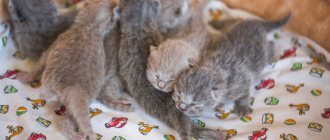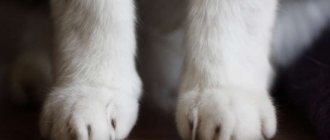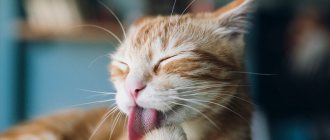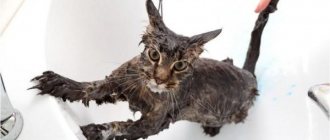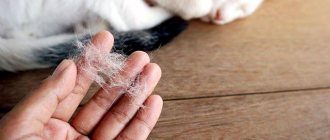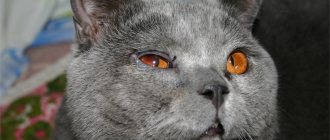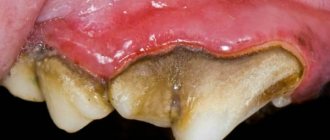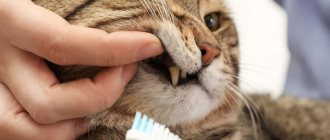Pregnancy detection
Healthy pets with a pedigree, veterinary passport and breeding value are allowed for breeding. In practice, a different picture can be observed. Domestic cats that freely visit the street find outbred males who do not have any regalia for mating.
It will not be possible to register the offspring from such matings in the breed club, so the kids will have to look for a new home for a very long time, and the kittens will be given away not for money, but for free. But this is the financial side of the issue, which, of course, should be foreseen in advance.
If mating is carried out under human control, and titled individuals participate in the process, the date of fertilization must be recorded. This will help determine the estimated date of birth of the offspring. When mating occurred without the knowledge of the cat owner, the gestational age can be determined by physiological signs and the changed behavior of the pet.
During pregnancy, the cat’s body undergoes restructuring, as evidenced by the following physiological signs:
- absence of heat. Pets over the age of 1 year estrus quite often (every 1-2 months), the onset of estrus can be recognized by characteristic behavior: purring, rubbing on the floor, night screams. If the cats' next calls do not occur as scheduled, it means the cat is pregnant;
- At about 3 weeks of pregnancy, the cat’s nipples swell and turn red;
- after the 4th week, you can notice rounded sides, and after the 6th week, the kittens can be felt moving in the womb.
To make sure that pregnancy has occurred, you need to show the animal to a veterinarian.
If mating proceeds according to a pre-planned plan, then the animals participating in the process must be checked for bacterial and infectious pathologies. In addition, before mating, animals must be treated for worms and other parasites.
Unplanned mating can be a reason for abortion. In the early stages of pregnancy this is allowed. Termination is also carried out for medical reasons, for example, if the pregnancy threatens the life and health of the pet.
Nutrition tips
The onset of pregnancy in a cat requires a review of its diet. From the 4th week, nutrition should be enhanced. If the cat was previously fed 2 times a day, then it is transferred to fractional feeding. The fruits developing in the womb begin to put pressure on the organs of the digestive tract, so the cat is not able to eat the previous portion of food at one time (read what to feed a pregnant cat).
An incorrectly formulated diet leads to the cat losing weight, and in severe cases, suffering from exhaustion. Diet errors are dangerous not only for the pregnant woman, kittens can also suffer. A starving cat's offspring are born weak and developmentally delayed. Lack of vitamins and microelements leads to the following deviations:
- against the background of improper mineral metabolism, problems with bone tissue appear, expressed in the terrible condition of bones and teeth. Babies grow up with curvature of limbs (rickets);
- Developmental defects are observed due to a lack of vitamins in the diet. This also negatively affects the nervous system and internal organs;
- improper salt metabolism ends in pathology of the structure of the teeth;
- Miscarriages occur when there is a lack of protein and amino acids in the diet. Without these substances, fruits do not develop, and the body gets rid of them.
To get healthy offspring, you need to take care of the proper nutrition of your pet even before pregnancy. In the first month after fertilization, all organs and systems of babies develop, which is why it is so important to pay attention to diet.
You should not purchase various food additives or vitamins from pet stores without consulting a veterinarian. Only a specialist should recommend what should be included in the diet. An excess of minerals and vitamins is just as dangerous as their deficiency.
The weight of a cat is of great importance, so it is necessary to weigh it regularly and record the data in a notebook. Fluctuations in indicators may indicate deviations; only a veterinarian can dispel doubts.
An increased appetite and rapid weight gain can cause obesity. This condition is a risk factor during pregnancy and childbirth.
How to understand that labor will begin soon: signs
There are several main signs by which you can determine the imminent labor activity in your cat:
- a few hours before the birth process begins, the pet begins to behave restlessly, refuses food, and in every way avoids contact with strangers;
- Colostrum gradually appears on the nipples. In addition, characteristic vaginal discharge may appear;
- About a day before the onset of labor, a pregnant cat's belly drops.
Important! To stimulate contractions, 0.3 ml of oxytocin can be administered intramuscularly every half hour. But it should be remembered that more than three injections are unacceptable.
Based on the above signs, you can know with 95% probability that the cat will give birth soon. The approximate date of birth can be calculated if you know the exact date of mating. Labor activity often begins on days 59-70.
Choosing a nest site
If you don't prepare a cozy and safe nest for your cat, she may find it on her own. In this case, it will be difficult to observe the birth process, because the cat can hide far under the sofa, behind a closet, in an open dresser drawer or some secluded place hidden from prying eyes.
About 2-3 weeks before giving birth, the pet begins to search for a nesting site. It is necessary not to miss this moment and offer the cat a good nest located within the owner’s reach. To arrange the nest, a durable box made of cardboard or plastic, which must be covered with a soft cloth, is suitable. This will make the habituation process easier, and the cat will be happy to rest in the nest. You will need another box in which to place newborn kittens.
During the birth process, the cat begins to discharge, so it is advisable to put a moisture-absorbing diaper in the box.
After the pets are born, the diaper is removed and the box is covered with natural cotton napkins. The fabric should not have any odors so as not to displease the cat. Until the umbilical cords fall off, the bedding must be changed at least once a day. Therefore, they prepare more of these napkins.
If before giving birth the cat realizes that the place for babies is not safe enough, she will move away from everyone. However, this cannot be allowed. After all, it is very difficult to help a woman in labor who is stuck under the sofa. In order not to frighten the cat away, it is better to allocate a separate room for labor, limiting access to children, other pets and strangers.
What absolutely should not be done
Sometimes the owner of a mustachioed friend can harm the animal due to inexperience. To prevent this from happening, take a close look at the list of things that are strictly forbidden to do when giving birth to a cat:
- Do not pull a newborn cat by the head or neck. It is also forbidden to pull too hard on just one paw.
- It is prohibited to use antiseptics that are intended for treating human wounds.
- Do not allow a giving birth cat to eat more than two placentas.
- It is prohibited to turn on bright lights in the maternity ward. Moreover, it should not be included in the first 2-3 weeks of a kitten’s life, as this can cause cataracts.
- In the first 2-3 hours, try not to pick up newborns. Leave them in the care of the mother: she will lick and warm the babies on her own.
Did you know? The cat sees practically nothing half a meter in front of him. That is why she can look for a long time for a tasty treat that you gave her right under her nose.
Never panic. Before giving birth, check your first aid kit and get ready, because usually there are no problems.
Dangerous symptoms
Excessive restlessness of the cat, copious discharge of an unusual color with an unpleasant odor should concern the owner. During a normal pregnancy, there should be no discharge before birth. The following symptoms warn of pathology:
- yellow-green discharge from the loop. Most likely, this is pus, provoked by the development of an infectious process in the uterus;
- the putrid smell of the discharge, its bright green tint occurs after the intrauterine death of kittens. Decomposition of the placenta is accompanied by unpleasant discharge;
- Blood may appear from the loop. This is also a dangerous signal warning of ruptured blood vessels or perforation of the uterus.
Pregnancy is a difficult test for the whole body. Stress leads to a decrease in immunity, so the cat can get a viral infection. Symptoms such as vomiting, diarrhea, sneezing, mucous or purulent discharge from the nose and eyes should be a reason to contact a veterinarian. Infectious diseases are fraught with the death of offspring or the formation of abnormalities.
What happens to a cat after giving birth?
The cat needs to be given time to restore its vitality. Check her well-being regularly to avoid worrying symptoms.
How does a cat behave after giving birth?
Normal state
The cat may have no appetite for the first 6-24 hours. If she drinks water at the same time, then everything is normal.
In a few days she will start going to the litter box. Don't be alarmed if you experience pink discharge from your perineum in the first week after giving birth.
Milk should appear immediately after birth. However, minor delays due to stress are acceptable. Once your cat has recovered, provide her with constant access to fresh food and water.
Signs of complications
Health problems can occur in young, injured or purebred cats. You should seek help from a veterinarian if your cat begins to exhibit the following symptoms:
- anxiety, restlessness and apathy;
- lack of appetite during the day;
- temperature increase to +39.4°C or decrease below +36.1°C;
- bleeding lasts 10 minutes or more;
- unnatural color of milk;
- persistent diarrhea and vomiting;
- trembling in the head and paws;
- discharge from the perineum after 3 weeks, which has an unpleasant odor or impurities of pus;
- swollen and hot nipples;
- indifference towards kittens.
If a female has brought many kittens, she may have milk fever at first. This is due to the fact that calcium levels in the body drop. Pathologies may be accompanied by the following symptoms:
- restlessness and rapid breathing;
- mucous membranes became pale;
- impaired coordination of movements;
- exposure of fangs;
- convulsions and loss of consciousness.
Baby's date of birth
The period of birth of kittens varies within 60-70 days after mating. Day 65-67 is considered optimal, but the body of each woman in labor is individual, so you should not rush to conclusions. If labor has not occurred by day 71, surgery is performed.
Decreased appetite on the eve of childbirth indicates the imminent arrival of babies. From this point on, it is necessary to conduct active preparations, call the veterinarian and arrange an appointment if the need arises.
What you need to have on hand to help
A non-specialist is unlikely to be able to accurately determine whether in a given specific situation the help of a specialist is needed or whether independent participation will be sufficient. But if it is definitely decided to control the birth without a veterinarian, then the list of available materials should be as follows:
- surgical gloves (disposable or sterile) – 2-3 pairs;
- moisture-absorbing medical diapers (unscented) – 4-6 pieces, depending on size;
- a small waffle towel (clean, intensively ironed) - may be needed for resuscitation of a weak newborn baby;
- gauze or bandage wipes (sterile) – up to 2 packs;
- good cutting blunt scissors;
- surgical silk, catgut or any other surgical thread for tying the umbilical cord - sterile initially or soaked in alcohol on the eve of the expected birth;
- a small rubber bulb (syringe) – for pumping out mucus from the kitten’s airways;
- sterile petroleum jelly;
- hydrogen peroxide 3%, betadine or brilliant green solution;
- ammonia;
- a heating pad or electric sheet if the room is cool.
We recommend reading: Pneumostop - instructions for using an antibiotic
Only after consultation with a veterinarian (!) the following are added to the list:
- oxytocin;
- lauritin;
- calcium gluconate;
- disposable syringes - insulin and regular, 2 ml volume.
In general, consultation with a veterinarian is required! If a decision has been made to perform obstetric care on your own, then there must be a clear understanding of what is needed, why, and when the use of this or that material/drug will be appropriate.
Childbirth kit
The process of giving birth to kittens is always exciting for owners. In order not to confuse anything in the chaos, you need to prepare in advance. The following items and tools should be placed near the nest:
- several disposable moisture-absorbing diapers;
- sterile gauze wipes, size 20x20 cm;
- a skein of thick silk thread that can be used to tie the umbilical cord;
- scissors for cutting the umbilical cord;
- stable container with water;
- small syringe;
- heating pad for babies;
- medical gloves;
- notebook;
- pen.
A first aid kit must be present. It contains:
- medical alcohol for disinfecting hands and instruments;
- hydrogen peroxide for treating the umbilical cord and occasional wounds;
- Streptocide, crushed into powder.
In addition, the first aid kit should contain ampoules with antibiotics, hormonal drugs and vitamins. This will allow emergency assistance to be provided to the woman in labor if necessary. The veterinarian will recommend the names of drugs for the first aid kit; after purchase, it is advisable to study the instructions and write down on a piece of paper what doses of the drug may be required.
The process of childbirth - norms and deviations
Most cats are able to give birth to offspring on their own and without the help of the owner. Do not interfere with the process if the cat behaves calmly and confidently.
Advice: Stay away, but within the cat's sight, if the birth proceeds without complications.
Forced intervention in the birth process can increase the pet’s stress and complicate the birth process. Carefully monitor your cat's behavior, breathing and movements. If, while in contractions, the cat gets up and goes to the tray, make sure that with efforts during defecation, a fetal sac does not appear in the birth canal. If this happens, pick up the cat and move its nest.
Help for a woman in labor
In most cases, the owner's assistance during childbirth is not required. If the cat is confident in its actions and is not nervous, it is better to just watch the process. Inept human actions can only frighten the animal and increase stress.
The woman in labor is closely monitored.
Sometimes during contractions the cat goes to the litter box. Therefore, it is necessary to place the tray near the birth site and monitor that the cat does not give birth when visiting the toilet.
When a fetal sac appears in the cat's birth canal, it is necessary to transfer the pet to the nest.
Contractions usually last up to 12 hours. If contractions are weak, the break between them is up to 40 minutes. During strong contractions, the cat behaves restlessly, contractile movements of the peritoneum are visually noted.
Active licking of the genitals indicates the imminent approach of childbirth, while the cat’s breathing becomes heavier, and the pet may meow. The animal's body temperature 12-24 hours before labor can drop to 37ºC.
During childbirth, it is necessary to control the amount of placenta released. In order not to confuse anything in the turmoil, the time of birth of each baby and the expulsion of the placenta are recorded in a notebook. If after birth the number of kittens does not correspond to the number of afterbirths released, the cat must be taken to the veterinarian. Placences remaining in the womb can trigger the development of endometritis.
The apartment should be as quiet and calm as possible during childbirth. Excessive noise, strangers and the attention of other pets cause anxiety in the woman in labor, which contributes to a protracted labor, and in some cases can cause the death of the fetus.
As soon as your cat begins to strain, you need to thoroughly wash your hands and prepare. During a normal birth, the cat takes a position on its side and pushes. It takes several attempts (3-4) for the kitten to appear. When an amniotic sac appears in the birth canal, the cat breaks it and begins to actively wash the baby.
Licking continues until the kitten begins to breathe. Following the kitten, the placenta is expelled from the uterus. Many cats eat the afterbirth after gnawing off the umbilical cord. The substances that make up the placenta help stimulate labor, so you can allow your pet to eat them. It is advisable that no more than 4 pieces are eaten, otherwise the cat may develop diarrhea.
A newborn baby can speed up the appearance of new contractions. The mother pushes him to the nipples, where the kitten begins to suckle colostrum. The time period required for the birth of the next babies is approximately 20-40 minutes. For the second and subsequent fetuses, fewer attempts are required (2-3 for each).
The birth is considered complete if 2 hours have passed since the birth of the last baby.
In some cases, it happens that the baby is born a few hours later. This indicates weak labor.
The veterinary clinic offers to undergo an ultrasound to accurately know the number of future babies. It is better to do this in the last week before giving birth. Embryos that die in the uterus in the early stages tend to dissolve, so early studies are considered uninformative.
Which cats need help during childbirth?
Ideally, preparation for childbirth in a cat should begin even before pregnancy - she should undergo a preventive examination by a veterinarian, after which the owner needs to find a healthy cat for mating. In addition, you need to take care of proper nutrition, vitamins and medications that the animal may need, and also think about “good hands” for kittens. This most often happens with purebred cats, but outbred pets are usually left to their own devices, their reproduction is not controlled by their owners, and pregnancy becomes a surprise.
Planned pregnancy in a Scottish Fold
The best way to avoid complications and troubles during childbirth is to monitor the health of the cat, especially in the last weeks of gestation. It is better to limit the activity of the expectant mother - she should not climb on high objects and jump from there, run or play for too long. It is recommended to minimize contact between the animal and children and other pets.
If the cat is healthy, the birth of kittens should be normal.
Not all cats require assistance during delivery; sometimes it is enough for the owner to simply observe that the process proceeds normally. Complications can occur in primiparous, weakened or sick females, but sometimes it happens that childbirth is difficult in absolutely healthy individuals. Particular attention should be paid to pets that suffer from cardiovascular and respiratory disorders - it is recommended to take such cats to a veterinary clinic for a cesarean section, and then immediately sterilize them.
In artificially bred cat breeds, childbirth can be difficult.
Artificially bred elite breeds endure childbirth worst of all, and they often lack maternal instinct, so owners sometimes have to take on the role of nanny to care for newborn kittens.
Attention! If a cat was taking any medications before giving birth, its health should be monitored especially closely - after some medications, cats are strictly forbidden to become pregnant, but it is not always possible to keep track of the animal. Even one injection given several months ago can lead to serious complications and even the death of the female.
Possible complications
There are times when a cat cannot give birth. In order not to get confused in such a situation, it is important to understand what is a deviation and what is the norm. An urgent call to the veterinarian is necessary in the following cases:
- the first contractions last more than 12 hours;
- pushing lasts more than 60 minutes;
- More than 1-2 hours have passed since the first kitten appeared, but there is no more pushing;
- the fetus is stuck in the birth canal and has been there for more than 20 minutes, but the pushing has stopped.
Help provided unprofessionally can only do harm. Therefore, without hesitation, you should call a veterinarian at home. If the specialist’s arrival is delayed, you can try to help a cat whose pet is stuck in the birth canal. To do this, fill the syringe with petroleum jelly, remove the needle and generously lubricate the loop area.
You can pull the kitten out only during the next push. Excessive force is prohibited. This may result in injury to the birth canal and the baby.
What to do with kittens if there are a lot of them?
If a cat has given birth to many kittens, it will be difficult for her to care for her babies without your help. First of all, you need to organize proper and timely feeding of newborns. To do this, you will need special milk that replaces cat milk. You can buy it at a veterinary pharmacy.
For feeding you will need a special bottle with a tiny nipple. This accessory is also sold in pharmacies and specialized pet stores.
Newborn kittens need to be fed small portions every 2-3 hours. As you grow, the dosage is gradually increased. You can find out the exact amount of daily food for newborn kittens from your veterinarian. This issue is especially important to discuss with a specialist if the cat gave birth to premature kittens.
Resuscitation actions
Sometimes dead kittens are born. This usually occurs when the fetus is malpresented and has a long passage through the birth canal. In this case, you can try to resuscitate the kitten. The baby is wiped with a dry cloth or towel and placed on a heating pad or under a lamp. It is necessary to perform a closed cardiac massage and perform artificial respiration.
Before carrying out measures for ventilation of the lungs, it is necessary to free the nasal passages and oral cavity from amniotic fluid. If the cat itself has not licked the baby, use a small syringe or syringe without a needle. Only after clearing the airways do resuscitation measures begin.
If the revival measures were successful, the kitten begins to squeak. He is placed on a heating pad and left for 10-15 minutes to restore strength. When the baby actively moves his limbs, he is transferred to the mother's nipples. If the pet is lethargic, it is rubbed again and warmed under a lamp, observing the restoration of mobility.
If the kitten was born in the amniotic sac, and the mother went about her business, it is necessary to rupture the membrane of the bladder near the muzzle and remove fluid from the respiratory tract. After the baby has begun to breathe, the umbilical cord is cut at the thinnest point, leaving about 5 cm. The baby is rubbed.
Also watch the video of the entire process of giving birth to a cat with assistance:
The need to induce labor
The doctor must make such decisions. This will eliminate complications and death of the pet. If kittens are born within a few hours of each other, stimulation will be required. Make sure your actions will not harm the cat first.
You will need to massage your nipples and belly a little. Afterwards, Oxytocin is administered. This will be a good solution if there is no mechanical blockade. The doctor decides whether to prick the animal or not. After all, the wrong dosage can cause rupture of the cervix, and also provoke the death of kittens and their mother.
